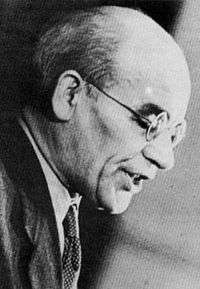Provisional Government of National Unity



The Provisional Government of National Unity (Polish: Tymczasowy Rząd Jedności Narodowej or TRJN) was a government formed by a decree of the State National Council (Krajowa Rada Narodowa) on 28 June 1945. It was created as a coalition government between the Polish Communists and Stanisław Mikołajczyk's faction. It followed the understandings reached by the Western Allies and the Soviet Union during the Yalta Conference.
The TRJN was a result of the negotiations held in Moscow between the Polish Communists, the Soviet Union, and Stanisław Mikołajczyk's faction from 17 June to 21 June. The Polish government-in-exile did not recognize the TRJN.[1] A few of its members, including the former Prime Minister of Poland Stanisław Mikołajczyk, decided to trust the Soviets and enter into negotiations with them, only to be betrayed later. Mikołajczyk's main power base was the Polish People's Party, a centrist organization and continuation of the prewar Polish agrarian movement.
The Communists had no intention of giving the opposition any real power, or carrying out the promised 'free and fair' elections. The members of the opposition that received government positions were kept in check by their deputies and staff, loyal to the Communists, so they had little real power.
On 21 June, General Leopold Okulicki, former Commander of the Polish Home Army was sentenced to 10 years of imprisonment in Moscow for the alleged sabotage against the Soviet Army. Ten other Poles were given similar sentences in the staged Trial of the Sixteen. On 24 December 1946, Okulicki died in Butyrka prison.
The TRJN was already bound by the Treaty of Friendship, Mutual Help and Cooperation signed by its predecessor, the Provisional Government of the Republic of Poland, on 21 April. This treaty formed the basis for Soviet interference in Poland's internal politics for the next 40 years.
The TRJN government was composed of:
- Prime Minister: Edward Osóbka-Morawski (Polish Socialist Party)
- Deputy Prime Minister, Minister of Regained Territories: Władysław Gomułka (Polish Workers' Party)
- Deputy Prime Minister, Minister of Agriculture and Agricultural Reform: Stanisław Mikołajczyk (Polish People's Party)
The entire government was composed of:
- Workers' Party: 7 people
- Socialist Party: 6 people
- People's Party: 3 people
- Polish People's Party: 3 people
- Democratic Party: 2 people
On 5 July 1945, the TRJN was recognized by the United States. It was soon also recognized by the other Allies, France and the United Kingdom. It was not recognized by the Vatican.
On 6 July, while the Polish government-in-exile maintained its existence, both the United States and the United Kingdom formally withdrew the recognition of it.
On 10 July, Osóbka-Morawski announced the expulsion of all Germans from Poland.
From 17 July to 2 August, a delegation from the TRJN attended the 1945 Potsdam Conference.
On 16 August, a Soviet-Polish border agreement was signed in Moscow. Before the end of August, Poland agreed to cede the eastern provinces to the Soviet Union and officially recognized the eastern border based on a slightly modified Curzon line.
On 16 October, delegates of the TRJN signed the United Nations Charter and Poland became a member of the United Nations.
The 'free and fair' elections promised by the TRJN were postponed until the Communists were sure they could control the election process. In the meantime, they increased repressions of opposition members, who were bribed, threatened, delegalised or even murdered. In the words of Gomułka, the goal of the communists was to be the "hegemon of the nation" and nothing would stop them. On 30 June 1946, they tested their control during the 3xTAK referendum, the results of which were falsified and a 68% support was claimed.
Two great reforms carried out by TRJN were the nationalization decree and Three-Year Plan (of 1947–49), both created in 1946. The nationalization decree gave the government control over every enterprise which employed more than 50 people; by the end of the year, 90% of the country's industry was controlled by the government.
On 19 January 1947, after the rigged Polish legislative elections of 1947, Mikołajczyk party's unsuccessful challenge, TRJN was dissolved and passed its prerogatives as the government of Poland to the new government headed by Józef Cyrankiewicz. Cyrankiewicz's government was nominated by the new parliament, Sejm Ustawodawczy, which replaced the previously existing Krajowa Rada Narodowa.
See also
- Polish Committee of National Liberation (Polski Komitet Wyzwolenia Narodowego or PKWN) - 1944/45
- Provisional Government of the Republic of Poland (Rząd Tymczasowy Rzeczypospolitej Polskiej or RTRP) - 1945
- Polish People's Party (1945–49)
- People's Republic of Poland (Polska Rzeczpospolita Ludowa or PRL) - 1944/52 (unofficial), 1952/89 (official)
- People's Army of Poland (Ludowe Wojsko Polskie or LWP)
- Polish government-in-exile
References
- ↑ Peter Stachura The Poles in Britain 1940-2000 ISBN 0-7146-8444-9 Page 7
- Davies, Norman, 1982 and several reprints. God's Playground. 2 vols. New York: Columbia Univ. Press. ISBN 0-231-05353-3 and ISBN 0-231-05351-7